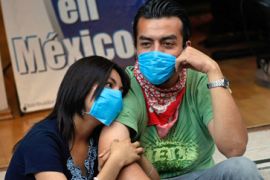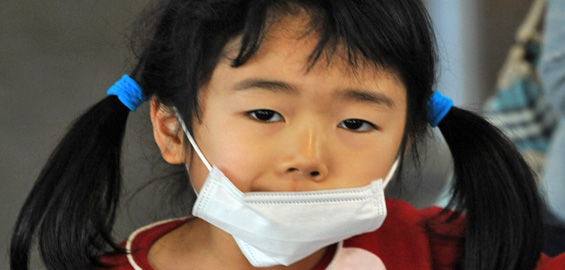Timeline: H1N1 outbreak
Mexican outbreak of deadly flu virus quickly spreads around the globe.

 |
| A ‘flu-like’ illness reported in Mexico has quickly spread around the world [AFP] |
From March 18 Mexican authorities began picking up cases of what the World Health Organisation called an “influenza-like-illness”, while in the weeks prior to the first recorded swine flu death, local media in Mexico was reporting an increase in instances of flu-like illnesses.
April 12 – A 39-year old woman suffering from an acute respiratory illness in a hospital in Oaxaca, Mexico, dies. She has been treated there for five days.
Keep reading
list of 4 itemsEvacuation orders issued as wildfire grows near Canada’s Alberta oil patch
Energy summit seeks to curb cooking habits that kill millions every year
Thousands evacuate as wildfire grows ‘dramatically’ in western Canada
In following days, local health authorities contact people who have been in contact with the woman and find some are displaying mild symptoms of pneumonia. They note that over 5,000 cases of pneumonia occur annually in Oaxaca and the woman’s death is declared an isolated incident.
April 16 – Mexican health officials contact the Pan-American Health Organisation, an arm of the WHO, over the illness.
April 21 – Oaxaca health department confirms a second death from the atypical pneumonia. Fearing an outbreak of what they believe could be avian flu, the hospital where the two deaths occurred establishes a quarantine in its emergency room.
April 22 – The Mexican health ministry issues a nationwide alert and samples are sent to Canada for testing.
April 23 – In the US, public health officials announce that seven people have been diagnosed with a flu virus known as H1N1, in California and Texas, but all seven recovered and it is at the time unclear whether these cases are related to Mexico’s outbreak.
| Special report |
 |
Later, Canadian public health authorities announce that the Mexican virus is the H1N1 “swine flu” virus.
April 24 – The WHO makes its first disease outbreak announcement – the body confirms that the US cases are the same virus as the cases in Mexico.
Mexican authorities are by now investigating suspected cases of swine flu in other parts of the country and schools in the capital and other parts of the country are closed as a precaution against the spread of the virus.
April 25 – An emergency committee of the WHO meet in Geneva to oversee the agency’s handling of the outbreak of the H1N1 virus, declaring it a “public health emergency”. (read the article here)
Mexico says that more than 1,300 people are suspected to have the virus. President Felipe Claderon issues an emergency decree giving the government powers to run tests on sick people and isolate them in an attempt to control the outbreak.
Officials in the US state of Kansas confirm cases of H1N1.
April 26 – Canadian officials confirm four cases of H1N1 on the country’s east coast. (read the article here)
The US declares public health emergency, with 20 cases of swine flu confirmed across five states.
New Zealand says that 10 students who travelled to Mexico have tested positive for flu and are “likely” to have contracted the H1N1 virus.
April 27 – Spain becomes first European country to confirm an outbreak of H1N1.
Soon afterwards, Britain confirms the a Scottish couple, retiring from their honeymoon in Mexico, also have the virus.
The WHO raises alert level to “phase 4”, meaning it is believed that the virus can be transmitted between humans to cause community-level outbreaks. (read the article here)
April 28 – Israel confirms its first case of swine flu, the first Middle Eastern country to be affected by the virus.
New Zealand confirms instances of the virus, while in Central America Costa Rica also confirms instances of H1N1. (read the article here)
Barack Obama, the US president, asks congress for $1.5bn to fight the outbreak to build drug stockpiles and monitor future cases of the virus.
| Infectious diseases in Asia |
|
Severe Acute Respiratory Syndrome, or SARS, first reported in Asia in February 2003, spread to 29 countries before being contained in May 2004. The World Health Organisation says Sars killed 774 people and sickened 8,098 others. First human infections with H5N1 virus, or ‘bird flu’, reported in Hong Kong in 1997. Six out of 18 cases proved fatal. By 2009, 257 deaths from bird flu have been recorded worldwide, with Indonesia the worst hit. Seven people in China and Vietnam have died. Ebola Reston virus found in pigs and six humans in the Philippines in 2009 in what is believed to be the virus’s first transmission from pigs to humans. |
April 29 – The US reports its first death from H1N1 – a 23-month-old Mexican child whose family crossed into Texas. The child’s death marks the first fatality from swine flu outside of Mexico. (read the article here)
In Europe, Germany, and later Austria, confirm instances of H1N1. (read the article here)
The WHO raises its alert level to “phase 5”, meaning there is sustained human-to-human spread in at least two countries. (read the article here)
April 30 – Egypt announces it intends to slaughter its entire pig population, even though no cases have been detected in Egypt and the WHO has said the disease cannot be caught from eating properly prepared pork.
The announcement angers many in Egypt’s Christian minority who keep most of the country’s 400,000 pigs and provokes clashes. The UN calls the intended slaughter “a real mistake”. (read the article here)
In Europe, the Netherlands, Switzerland and Ireland all confirm instances of the virus. (read the article here)
May 1 – Police in Hong Kong seal off the Metropark hotel in the island’s Wanchai district after test results on a 25-year-old Mexican man confirmed he has the virus.
Police order approximately 200 guests and 100 staff to stay in the hotel for the next seven days, much to their dismay.
Mexico begins a five-day shutdown of most offices and businesses on Friday to try to halt the spread of the deadly flu.
Major US airlines announced they are cutting down their services to Mexico due to lower demand for flights.
The WHO notes there are 331 reported cases of H1N1 in 11 countries and warns that the traditional flu vaccines have little effect against the virus.
May 2 – South Korea confirms its first instance of the virus, quarantining a 51-year-old woman who had returned from a trip to Mexico. (read the article here)
France, Denmark and Italy report their first confirmed cases of H1N1.
In Panama, police detain an American man who ran away from a hospital that was testing him for the virus.
Mexico lowers its suspected death toll from as many as 176 people to 101, but the WHO raises the overall confirmed number of human cases of H1N1 to 615. There have been 17 confirmed deaths so far, all but one in Mexico.
India says it is monitoring a suspected case of H1N1.
China suspends flights to Mexico.
May 4 – China defends its decision to quarantine 70 Mexican citizens due to fears of the H1N1 virus, despite complaints from Mexican authorities over cited discrimination (read the story here).
Portugal confirms its first case of the H1N1 virus.
May 5 – Mexico announces that it will reopen universities, schools and day care centres. WHO says that the number of confirmed cases has passed the 1,000 mark, with incidents of the virus rising in countries such as Spain and the UK (read the story here).
Mexico sends aircraft to China to pick up 70 Mexicans quarantined due to fears of the virus spreading (read the article here).
| In depth |
|
|
May 8 – Hong Kong ends quarantine of a hotel containing about 300 guests and staff members that lasted for a week in an attempt to contain the virus (read the article here).
WHO says that more than 2,300 cases of H1N1 have been confirmed in 24 countries.
May 10 – Number of deaths from the virus reaches 50 people (read the article here).
Japan and Norway identify their first confirmed cases.
May 11 – China confirms first H1N1 case (read the article here).
May 12 – WHO says that more than 5,000 cases of the H1N1 virus have been confirmed worldwide (read the article here).
Finland, Thailand and Cuba join the list of nations with reported cases.
May 19 – About 8,000 cases have occurred in 40 countries, with a total of 74 fatalities from the virus.
May 24 – Eighteen US soldiers at a military base in Kuwait have test positive for H1N1.
May 30 – Cyprus confirms its first case of H1N1.
June 12 – WHO declares a H1N1 pandemic – raising its warning level from five to six, its highest alert – after an emergency meeting in Geneva (read the story here).
June 14 – Scotland reports first death from H1N1 virus. It is the first death in a patient with the A(H1N1) virus outside the Americas.
Australian government raises its H1Ni flu alert as the national tally hit 1,458 cases. It is the worst-hit Asia-Pacific country with the fifth highest number of cases worldwide.
Nearly 30,000 people have contracted the virus, with 145 deaths.

 Q&A: What is swine flu?
Q&A: What is swine flu?